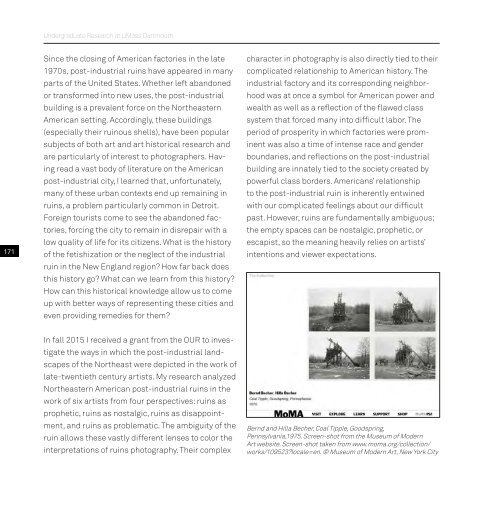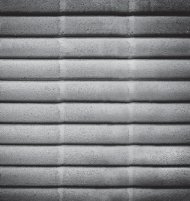Undergrad_Book_16-18_Pge_View_Print_no print marks_compressed
You also want an ePaper? Increase the reach of your titles
YUMPU automatically turns print PDFs into web optimized ePapers that Google loves.
<strong>Undergrad</strong>uate Research at UMass Dartmouth<br />
171<br />
Since the closing of American factories in the late<br />
1970s, post-industrial ruins have appeared in many<br />
parts of the United States. Whether left abandoned<br />
or transformed into new uses, the post-industrial<br />
building is a prevalent force on the Northeastern<br />
American setting. Accordingly, these buildings<br />
(especially their rui<strong>no</strong>us shells), have been popular<br />
subjects of both art and art historical research and<br />
are particularly of interest to photographers. Having<br />
read a vast body of literature on the American<br />
post-industrial city, I learned that, unfortunately,<br />
many of these urban contexts end up remaining in<br />
ruins, a problem particularly common in Detroit.<br />
Foreign tourists come to see the abandoned factories,<br />
forcing the city to remain in disrepair with a<br />
low quality of life for its citizens. What is the history<br />
of the fetishization or the neglect of the industrial<br />
ruin in the New England region? How far back does<br />
this history go? What can we learn from this history?<br />
How can this historical k<strong>no</strong>wledge allow us to come<br />
up with better ways of representing these cities and<br />
even providing remedies for them?<br />
character in photography is also directly tied to their<br />
complicated relationship to American history. The<br />
industrial factory and its corresponding neighborhood<br />
was at once a symbol for American power and<br />
wealth as well as a reflection of the flawed class<br />
system that forced many into difficult labor. The<br />
period of prosperity in which factories were prominent<br />
was also a time of intense race and gender<br />
boundaries, and reflections on the post-industrial<br />
building are innately tied to the society created by<br />
powerful class borders. Americans’ relationship<br />
to the post-industrial ruin is inherently entwined<br />
with our complicated feelings about our difficult<br />
past. However, ruins are fundamentally ambiguous;<br />
the empty spaces can be <strong>no</strong>stalgic, prophetic, or<br />
escapist, so the meaning heavily relies on artists’<br />
intentions and viewer expectations.<br />
In fall 2015 I received a grant from the OUR to investigate<br />
the ways in which the post-industrial landscapes<br />
of the Northeast were depicted in the work of<br />
late-twentieth century artists. My research analyzed<br />
Northeastern American post-industrial ruins in the<br />
work of six artists from four perspectives: ruins as<br />
prophetic, ruins as <strong>no</strong>stalgic, ruins as disappointment,<br />
and ruins as problematic. The ambiguity of the<br />
ruin allows these vastly different lenses to color the<br />
interpretations of ruins photography. Their complex<br />
Bernd and Hilla Becher, Coal Tipple, Goodspring,<br />
Pennsylvania,1975. Screen-shot from the Museum of Modern<br />
Art website. Screen-shot taken from www.moma.org/collection/<br />
works/109523?locale=en. © Museum of Modern Art, New York City



